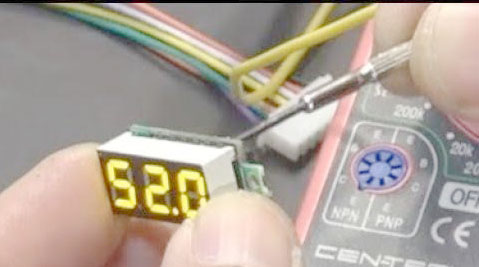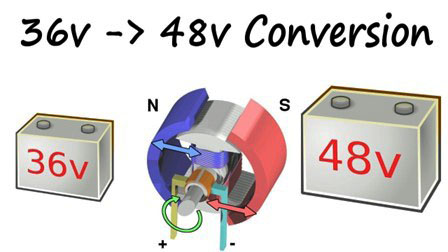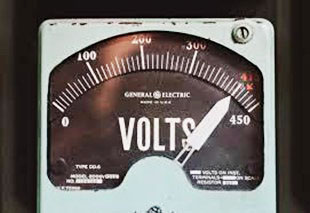The ebike battery voltage doesn’t only influence the performance of an electric bike. It also plays a vital role in the efficiency of the ebike.
Think of the voltage of the bike’s battery as electrical pressure. This pressure is responsible for powering the battery, as it triggers the movement of electrons within it.
But to understand all that, you will need a comprehensive ebike battery voltage chart. The information is essential to purchasing an efficient ebike.
An ebike battery voltage chart provides the different voltage and their corresponding power output. It talks about the different levels of charge percentage and the voltage provided by each percentage. This gives an accurate reading of the battery power through a voltmeter.
Let’s discuss all its critical information with the best voltage point for an electric bike. We’ll also cover how you can identify the voltage of your e-bike battery.
Electric Bike Battery Voltage Explained
The speed and power of an electric bike depends on 3 basic energy measurements:

- Voltage (V)
- Watts (W)
- Amp-hours (Ah)
The integration of the figures backing up these units determines the strength of an electric bike battery.
Let’s now address the volts as a unit of electric bike performance.
Ebike Battery Voltage
Generally, when we talk about volts, we’re referring to the measurement of tension. This also has to do with the pressure within the battery. In simple words, the volt is the power of the battery. It’s also a factor that contributes slightly to the speed of the ebike.
The main determinant for the speed of an electric bike is the amp-hours. It’s not uncommon for people to confuse volts for amp-hours.
Here’s a short clip that explains both:
It’s practically unlikely for an ebike with a 48-volt battery to run at 50 mph. Why? A 48-volt battery lacks the pressure capacity to spin the wheels up to the required number of revolutions for such speed. However, in terms of going up steep hills, a 36-volt battery will not match that of 48 volts.
To better understand an electric bike’s voltage, think of the flow of water in a pipe.
Here’s a virtual description of this scenario:
When it comes to electric bike batteries, the usual volts sequence comes in 12. This means if there’s a 12-volt ebike battery, the following volts would be 24 volts.
Generally, electric bike batteries come in four most recognized volts, including the 12 volts, 24 volts, 36 volts, and 48 volts. There are also the 52 volts, 60 volts, 72 volts, 84 volts, and 120 volts batteries, which are not commonly used.
Let’s look at an ebike battery voltage chart of some of these battery volts.
Ebike Battery Voltage Chart
| 36 Volts | 48 Volts | 52 Volts | 60 Volts | 72 Volts | |||||
| Battery | 36V 10S | Battery | 48V 13S | Battery | 52V 14S | Battery | 60V 16S | Battery | 72V 20S |
| % | Volts | % | Volts | % | Volts | % | Volts | % | Volts |
| 100 | 42.0 | 100 | 54.6 | 100 | 58.8 | 100 | 67.2 | 100 | 84.0 |
| 95 | 41.4 | 95 | 53.8 | 95 | 58.0 | 95 | 66.2 | 95 | 82.8 |
| 90 | 40.8 | 90 | 53.0 | 90 | 57.1 | 90 | 65.3 | 90 | 81.6 |
| 85 | 40.2 | 85 | 52.3 | 85 | 56.3 | 85 | 64.3 | 85 | 80.4 |
| 80 | 39.6 | 80 | 51.5 | 80 | 55.4 | 80 | 63.4 | 80 | 79.2 |
| 75 | 39.0 | 75 | 50.7 | 75 | 54.6 | 75 | 62.4 | 75 | 78.0 |
| 70 | 38.4 | 70 | 49.9 | 70 | 53.8 | 70 | 61.4 | 70 | 76.8 |
| 65 | 37.8 | 65 | 49.1 | 65 | 52.9 | 65 | 60.5 | 65 | 75.6 |
| 60 | 37.2 | 60 | 48.4 | 60 | 52.1 | 60 | 59.5 | 60 | 74.4 |
| 55 | 36.6 | 55 | 47.6 | 55 | 51.2 | 55 | 58.6 | 55 | 73.2 |
| 50 | 36.0 | 50 | 46.8 | 50 | 50.4 | 50 | 57.6 | 50 | 72.0 |
| 45 | 35.4 | 45 | 46.0 | 45 | 49.6 | 45 | 56.6 | 45 | 70.8 |
| 40 | 34.8 | 40 | 45.2 | 40 | 48.7 | 40 | 55.7 | 40 | 69.6 |
| 35 | 34.2 | 35 | 44.5 | 35 | 47.9 | 35 | 54.7 | 35 | 68.4 |
| 30 | 33.6 | 30 | 43.7 | 30 | 47.0 | 30 | 53.8 | 30 | 67.2 |
| 25 | 33.0 | 25 | 42.9 | 25 | 46.2 | 25 | 52.8 | 25 | 66.0 |
| 20 | 32.4 | 20 | 42.1 | 20 | 45.4 | 20 | 51.8 | 20 | 64.8 |
| 15 | 31.8 | 15 | 41.3 | 15 | 44.5 | 15 | 50.9 | 15 | 63.6 |
| 10 | 31.2 | 10 | 40.6 | 10 | 43.7 | 10 | 49.9 | 10 | 62.4 |
| 5 | 30.6 | 5 | 39.8 | 5 | 42.8 | 5 | 49.0 | 5 | 61.2 |
| 0 | 30.0 | 0 | 39.0 | 0 | 42.0 | 0 | 48.0 | 0 | 60.0 |
What Is The Best Voltage For An E-Bike?
There’s not really one best voltage for all electric bikes. It boils down to your reason for purchasing the ebike. The power of the bike is a function of the voltage. This means that the higher the battery voltage, the more it performs.

For instance, while a 24-volt battery ebike is suitable enough for cruising around, but it might struggle while going up steep hills. Likewise, using a 48V or 52V battery ebike for casual rides limits its capacity.
The most important is knowing the right voltage for your need. Now, the question may be, how can you identify the ideal voltage for an ebike?
Things to Consider When Determining the Best Voltage for an Ebike
- You first want to familiarize yourself with the fundamentals of the various battery packs such as 10S, 13S, 14S, etc. Then, you’ll need to be certain of your need and budget.
- Next, consider the range of the battery. This refers to how long it can last once it’s fully charged. There’s a way to identify the range of these batteries. That has to do with weight.
Generally, a 6-pound to an 8-pound battery will cover a distance of 20 miles, equivalent to 32 kilometers.
So, you can use this information to determine how far your ebike can go or how long the battery will last.
- The watt-hours also play an important role in how long a battery will last. It’s one of the most effective ways to get the precise energy contained in a battery pack. Always look out for the number backing up the symbol “WH.” You can then relate this unit to the amount of Watts given off.
For example, 500wh will offer 500 watts for an hour. 500wh can offer 1000 watts, which will last for 30 minutes, and 250 watts for 2 hours.
Here’s a table for a clearer explanation:
| Battery Energy (Watt Hours) | Load | Run Time (Hours) |
| 500 Watt-hours | 250 watts | 2 hours |
| 500 Watt-hours | 500 watts | 1 hour |
| 500 Watt-hours | 1000 watts | 30 minutes |
Watch this video from Tower E-bikes to understand more about e-bike watts and amp-hours:
How Do I Know What Voltage My Ebike Battery Is?
One simple way to know an ebike battery’s voltage is through a multimeter. This option is good because it gives precise figures. The process may differ slightly with different types of multimeters or ebike batteries, but it’s pretty straightforward.

But to do this, you’ll need a multimeter, test leads, and the ebike battery to be tested. Here’s the step-by-step procedure to achieve this.
Step 1: Turn on the multimeter and make sure to set it on DC.
Step 2: If the battery comes with cables (positive and negative), connect the test leads or probes of the multimeter to the positive and negative terminals of the battery’s cables. The black probe goes into the black terminal of the battery’s cable, and the red probe into the red terminal.
That should give you the actual voltage of the ebike battery.
Step 3: The ebike battery may also come with its charging terminals. You can connect the positive and negative probes of the multimeter to the positive and negative charging terminals of the battery. Doing this will also give you the voltage of the electric bike battery.
Note that this is for an ebike battery with cable connectors. There are also hard-case electric bike batteries, which we’ve addressed below.
For A Hard-Case Ebike Battery
Step 1: Take note of the polarity of the pins of the battery, which refers to the positive and negative terminals.
Step 2: Once you can identify the polarity of the pins, connect probes to them according to the right polarity. If you do this correctly, you should get the right voltage for the battery.
Also, note that some brands of multimeter can be pretty complex. Such multimeters may require a little more setup before the test.
The above steps might be a bit puzzling to grasp. So, here’s a visual of the procedure:
Is 48V Better Than 36V?
When it comes to power and performance, a 48-volt ebike battery will always outmatch that of 36 volts. This is evident in their ranges, speed, etc. However, in terms of weight, a 36-volt electric bike battery is the better choice.

This is not surprising, since the weight of the battery determines its capacity. Now, let’s make a little comparison between the different volts.
More Volts Give You More Range
The range refers to the amount of power contained in the battery or the power which the battery provides to the ebike.
- Range of a 48-volt ebike Battery: Using a 48-volt battery on your ebike, you can be sure to cover a distance of 20 to 30 miles. However, this depends on the amp hours and watts in play.
- Range of a 36-volt ebike Battery: With a 36-volt ebike battery, it’s possible to cover a distance of about 18 to 22 miles. Again, this depends on the watts and amp-hours of the battery.
Comparing both ranges, it’s obvious that the 48 volts battery surpasses that of 36 volts.
Battery Weight
- Weight of a 48-volt ebike battery: The weight of a 48-volt electric bike battery is about 8 kg, approximately 17.63lbs. This may pose discomfort during a ride, which is considered a caveat. However, the weight also depends on the type of battery. A lithium-ion battery will not weigh as much as that of Lead-Acid.
- Weight of a 36-volt ebike battery: A typical 36 volts electric bike battery weighs around 4lbs, about 1.8 kg. This weight seems a lot of lighter and might not be noticed upon a ride. Moreover, it’ll be much easier to perform sharp turns and better control the bike.
So, considering both weight values, it’s clear that the 36-volts battery is more advantageous.
Battery use cases
- Application of a 48-volt ebike battery: It’s quite easy to cover several trails using a 48-volt ebike battery. Also, you will not need to bother about the mode you want to ride. This is a result of its wide range.
- Application of a 36-volt ebike battery: Conversely, there is a limit to the trails you can ride on with a 36-volt ebike battery. A 36-volt ebike battery won’t be a bad idea if you intend to use your ebike for casual rides within the town. Also, you will need to be mindful of the mode.
This is so that you don’t run down the battery too soon.
When we talk about the riding mode, we’re referring to the force that pushes the bike. So, to save battery health, you may need to engage the pedals from time to time. But, this depends on the distance you intend to cover.
So, in terms of application, getting a 48-volt ebike battery will prove more beneficial.
Will A Higher Voltage Battery Make My Ebike Faster?
A higher voltage will make an ebike faster. It, in fact, is one of the ways to increase the speed of an ebike. But, it’s advisable to consider the capability of the electric bike controller and BMS before attempting an upgrade.

Here’s an illustration that displays the speed difference between a 36-volt ebike and that of 48-volts:
You’re already familiar with the advantage of upgrading your electric bike, so let’s consider a few caveats with this move.
If your ebike is not compatible with the upgrade, the chances are that the controller can burn up after the change. Also, you may lose the accurate reading of the battery meter. As such, you may also need to upgrade it to the right voltage.
Frequently Asked Questions
Here are some of the most frequently asked questions about ebike battery voltage levels:
Can I use a 52V battery on a 48V motor?
You can use a 52-volt battery on a 48-volt motor, provided the bike uses an LCD screen. This is because the changes with the upgrade won’t affect such screens.
Moreover, 52 volts ebike batteries are fashioned to operate on 48 volts ebikes with an LCD screen. Some examples of these ebikes are RipCurrent S and CrossCurrent S.
What is the lowest voltage for 48V battery?
The lowest voltage for a 48V battery is about 39V. Also, don’t allow the battery’s capacity to go lower than 80%. This is so that it maintains a healthy life cycle.
Conclusion
An ebike battery voltage chart clearly outlines the charging percentage and different voltage of various ebike batteries. You can use these charts when planning to get an electric bike or its battery. This keeps you on the right track for the choice to make.
Also, it’s pretty simple to know the voltage of your ebike battery. One easy way to achieve this is by using a multimeter. Simply refer to the guidelines in this post for detailed information.
